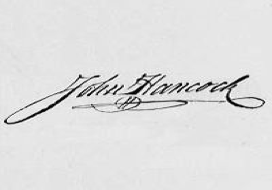John Hancock
(1737 – 1793)
Born in Braintree, Massachusetts in 1737, he was orphaned as a child, and adopted by a wealthy merchant uncle who was childless. Hancock received a privileged childhood education, was admitted to the Harvard Business School, and graduated at the age of 17. He then went to work in Boston as a clerk in his uncle’s counting house and soon became a partner in the firm. Hancock was only 26 years old when his uncle died, leaving John with a thriving business and what was said to be the greatest body of wealth in New England. This placed him in a society of men who had great affluence and social power and who were suspected of being loyal to the King of England. Hancock, however, became very involved in revolutionary politics and his sentiments were clearly for independence from Great Britain.
In 1765, the British Parliament imposed a direct tax on all printed materials in the American Colonies. This tax was known as the British Stamp Act. Again in 1767 the Townshend Revenue Acts were passed by Parliament, taxing imported paper, tea, glass, lead and paints. In 1768, the British seized John Hancock’s sloop, the "Liberty," for an alleged evasion of the laws of trade, causing a riot in Massachusetts, with the royal commissioners of customs barely escaping with their lives. Soon afterward, Hancock organized the Boston Tea Party. In retaliation royal transport ships brought British troops to Boston, beginning an unpopular military occupation of that port city that would last until March 17, 1776.
In 1774 Hancock was elected, with Samuel Adams, to the Provincial congress at Concord, Massachusetts, and he subsequently became its president. The British Commanding General ordered a military expedition to Concord in April, 1775 to capture Hancock and Adams. This military movement resulted in the Battle of Lexington and the “The Shot heard ‘round the World”. With the aid of Paul Revere both Hancock and Adams escaped with their lives. On June 12th, British General Gage issued a proclamation offering pardons to all the rebels, excepting Samuel Adams and John Hancock, "whose offences," it was declared, "are of too flagitious a nature to admit of any other consideration than that of condign punishment."
In May 1775 John Hancock was elected President of the Second Continental Congress and a year later on July 4, 1776 presided over the unanimous adoption of a draft copy of the Declaration of Independence, declaring that the Thirteen Colonies in North America were "Free and Independent States.” Hancock was the only person to sign this document. It wasn’t until August 2nd (232 years ago this month) that the 55 other delegates gathered and signed an engrossed copy.
At the signing, Benjamin Franklin is quoted as having replied to a comment by Hancock that they must all hang together: "Yes, we must, indeed, all hang together, or most assuredly we shall all hang separately," a play on words indicating that failure to stay united and succeed would lead to being tried and executed, individually, for treason. After its adoption by Congress on July 4, the handwritten draft signed by John Hancock (see signature on page one) was sent a few blocks away to the printing shop of John Dunlap. Through the night between 150 and 200 copies were made, now known as "Dunlap broadsides". The first public reading of the document was by John Nixon in the yard of Philadelphia’s Independence Hall on July 8. One was sent to George Washington on July 6, who had it read to his troops in New York on July 9. A copy reached London on August 10.
The Declaration of Independence was not divided into formal sections; but it is often discussed as consisting of these five parts:
Introduction
Asserts as a matter of the Laws of Nature and of Nature's God, a people are entitled to assume political independence; acknowledges that the grounds for such independence must be reasonable, and therefore explicable, and ought to be explained.
Preamble
Outlines a general philosophy of government that justifies revolution when government harms natural rights. “We hold these truths to be self-evident....”
Indictment
A bill of particulars documenting the king's "repeated injuries and usurpations" of the Americans' rights and liberties.
Denunciation
This section essentially finished the case for independence. The conditions that justified revolution have been shown.
Conclusion
The signers assert that there exist conditions under which people must change their government that the British have produced such conditions, and by necessity the colonies must throw off political ties with the British Crown and become independent states.
John Hancock would serve through some of the darkest days of the Revolutionary War, including Washington's defeats in New York and New Jersey as well as Great Britain's occupation of Philadelphia, until resigning his office in York, Pennsylvania on October 30, 1777. Hancock's vanity had offended many members of Congress, particularly his fellow Massachusetts delegates, and when Congress voted to thank Hancock for his service, the other Massachusetts delegates voted against the resolution. In January 1776, he was appointed commander in chief and major general of the Massachusetts militia. In July 1778, he led 6,000 of his militia in a failed attack on the British at Newport, Rhode Island. Then from 1780–1785, he was governor of Massachusetts. Hancock's skills as orator and moderator were much admired, but during the American Revolution he was most often sought out for his ability to raise funds and supplies for American troops. Despite his skill in the merchant trade, even Hancock had trouble meeting the Continental Congress's demand for beef cattle to feed the hungry army.
Hancock married Dorothy Quincy and he and Dorothy had two children, neither of whom survived to adulthood. John Hancock died on October 8, 1793 at the age of 56, but today his name is on two tall skyscrapers. One is located in Boston while the other is in Chicago, both built by the John Hancock Life Insurance Co.

